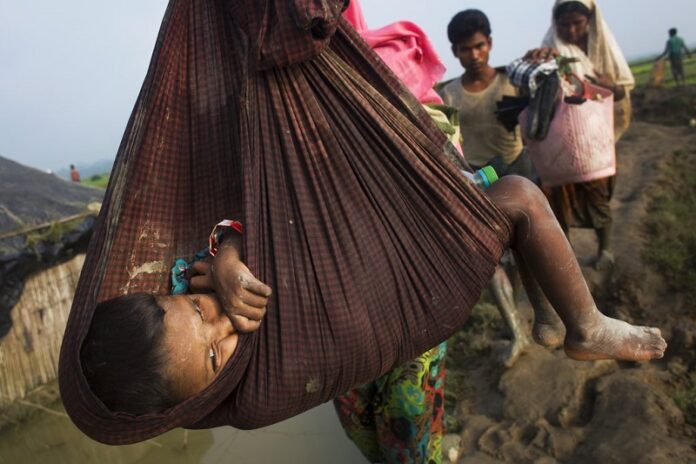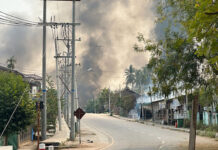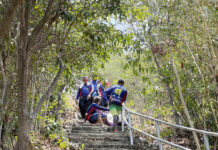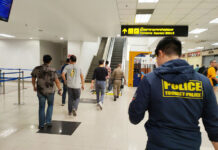
TEKNAF, Bangladesh — As far as the eye can see, they trudge through treacherously deep mud, across rice paddy fields and past rain-swollen creeks into Bangladesh.
Tens of thousands of Rohingya Muslims, fleeing the latest round of violence to engulf their homes in Myanmar, have been walking for days or handing over their meager savings to Burmese and Bangladeshi smugglers to escape what they describe as certain death.
Exhausted mothers clutched listless infants. Catatonically terrified children clung to bone-weary fathers. Young children with blank eyes carried even younger siblings.
“Oh Allah, Oh Allah,” one family moaned as they waded Tuesday through the chin-high waters of the Naf River dividing the two countries. One panicking woman handed a 3-month-old infant to a taller man before she slipped momentarily beneath the murky water. For a terrifying moment, the man held the baby aloft with one hand as he steadied himself. Then as the woman remerged, the group moved on to the safety of Bangladesh on the opposite bank.
The Rohingya Muslim ethnic minority from Myanmar’s western Rakhine state has faced systematic persecution at the hands of the Buddhist majority for decades. The military junta that ruled the nation for decades stripped them of their citizenship. The democratically elected government under the leadership of the Nobel Peace Prize-winning Aung San Suu Kyi has looked the other way as the Rohingya were pushed into squalid camps in their own home towns and villages.
For a people who have already lived through unimaginable horrors, including mass rapes and brutal killings decried by the United Nations, it seems as if the misery will never end.
Fresh horror was unleashed on Aug. 25, when fighters of the Arakan Rohingya Salvation Army attacked government forces and prompted Myanmar soldiers to retaliate with “clearance operations” they say were aimed at flushing the insurgents out from Rohingya villages.
The Myanmar government blames the insurgents for setting fire to their own homes and killing Buddhists in Rakhine.
The exhausted and starving refugees pouring into Bangladesh tell a different story: of targeted shootings by Myanmar troops; of warnings to leave their homes if they wanted to live.
And so they left.
They abandoned all but what they could carry – a few kitchen utensils, a bag of rice, a tattered mattress.
On a mound of river clay, Dilara Begum sat, too exhausted to move as the half-naked son she cradled in one arm ran his tongue over his chapped lips. Two other children filled a plastic water bottle with the swirling brown river water and then each took small sips in turn.
The Myanmar army burnt the houses in Begum’s village near the town of Maungdaw as the residents fled.
“I’m very hungry,” Begum said in a low moan. She could not remember when the family last ate. She had no food and hardly any money left after paying a smuggler about 10,000 Myanmar kyat, worth about USD $7.40, for each person in her family to be carried across the river in a rickety wooden boat.
One of the many boatmen plying the Naf River amid the refugee crisis said he has ferried thousands of Rohingya over the last 10 days – an exodus he said was like nothing he’s ever seen.
Many of the refugees have washed into the border district of Cox’s Bazar, where Teknaf town is located. Huddled with wide-eyed children, they occupied every available space — in little knots along the streets, in large groups on grassy knolls between rice fields.
Having escaped their destroyed homes, they weren’t sure what they would do next.
Ahead lay hunger, homelessness or possibly disease in overcrowded refugee camps.
Bangladesh, one of the world’s poorest countries, was already sheltering some 100,000 Rohingya refugees before another 123,000 flooded in after Aug. 25, according to the U.N. refugee agency’s latest estimate on Tuesday.
With aid groups unable to access violence-ridden areas of Myanmar, it’s unclear how many are left behind.
Some of the refugees in Bangladesh have found shelter with relatives in camps built in the 1990s.
Tens of thousands of others squat in open fields or collect bamboo sticks from the nearby woods to build their own shelters.
In the markets of Cox’s Bazar, some have sought to profit from the tragedy. Sticks of bamboo that normally sell for about 75 Bangladeshi taka (90 U.S. cents) are now selling for 200 taka (about USD $2.50).
There are multiple points on the border where Rohingya can cross by foot or by boat. When the tide was low, some boatmen were stopping a few hundred meters (yards) short and asking people to wade in the rest of the way.
Last week, at least three boats capsized, spilling dozens of people into the brackish waters. Some managed to swim to safety, but at least 26 people drowned.
Nur Kabir said he crossed the river on Sunday, and that many more have tried to swim the expanse on their own strength.
“They try to cross the river at night and drown,” Kabir said.
Some members of the Bangladeshi Border Guards, moved by the suffering around them, have interpreted the government’s silence about the refugee influx in recent days as approval for letting them in.
“This is a time to show humanity,” one paramilitary soldier said, asking that he and his colleagues not be named because they were not authorized to speak with the media. Officials “haven’t said let them enter. But they haven’t said stop them either.”
Another guard said they were trying to guide the terrified refugees crossing the river to spots along the slippery bank where it was easier to clamber up out of the water.
“I saw a woman with a 13-day-old baby. Her breastmilk had dried. She was feeding her baby this dirty water,” he said.
“That made me cry.”
Story: Muneeza Naqvi












































